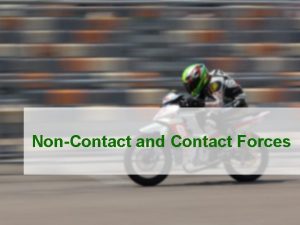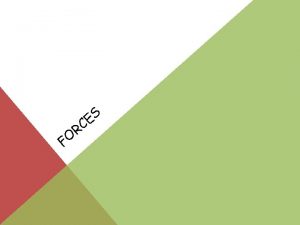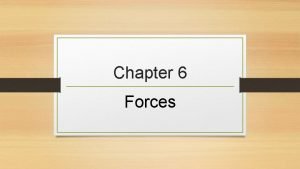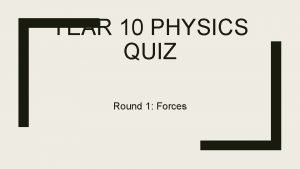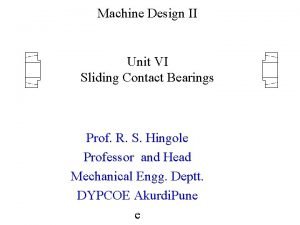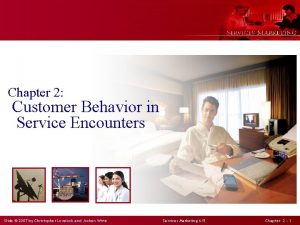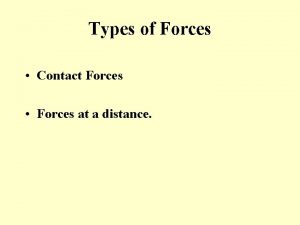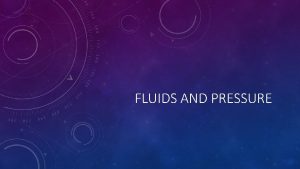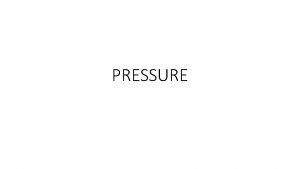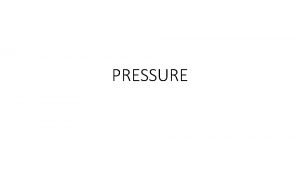FORCE AND PRESSURE TYPES OF FORCES CONTACT FORCES










- Slides: 10

FORCE AND PRESSURE TYPES OF FORCES CONTACT FORCES FRICTIONAL FORCE NON- CONTACT FORCES MUSCULAR FORCE (i)GRAVITATIONAL (ii)MAGNETIC (iii)ELECTRIC

PRESSURE α Force acting on the surface α 1 ----------Surface Area

APPLICATIONS Buses & trucks are double wheeled Buildings & dams have a wide base Railway tracks have wooden sleepers Tanks and bulldozers have caterpillar wheels

Link to be visited � https: //www. youtube. com/watch? v=E_JVp. DJ 2 9 rc

QUESTIONS FOR PRACTICE(Write the answers in the notes notebook) � Q 1 Identify the agent exerting the force � (a) squeezing a piece of lemon between fingers � (b)A person diving into the swimming pool � (c)A labourer moving a loaded cart � (d)An athlete making a high jump to clear a bar kept at a certain height. Answers will be discussed in the audio

Instructions for work in fair copy � Write the name of the chapter in the index � Date and name of the chapter on the new page � First you have to write the questions and answers shared in this ppt (part D: Q 4, 6 & Part E Q b, e and Q 4 ) � I will be sharing an audio to discuss other answers. You need to sit with your book pages , pen and copy. You will write the keywords as discussed in the audio and frame your own answers. � Write questions of all answers being discussed in the auio before the next class

CHAPTER END EXERCISE – PART D � Q 4. When we throw a ball upwards , what happens to its speed while its going up and why ? � Ans : The speed of the ball decreases because the gravitational force pulls it down towards the earth.

PART D � Q 6. How would the pressure (exerted by a force) change if : � (a) the area is doubled keeping the thrust constant � Ans : Pressure = thrust / Area � So, when area is doubled, pressure becomes half � (b) the thrust is doubled keeping the area constant � Ans : Pressure is directly proportional to thrust. So it gets doubled.

PART E Q 3 b) Give reason why potters place a large round piece of cloth on their heads when they carry heavy loads � Ans : i) pressure is inversely proportional to contact area � ii) round cloth increases the contact area thereby reducing the pressure. � e) It is easier to burst an inflated balloon with a needle than with the finger � Ans i) pressure is inversely proportional to contact area � Ii)needle having lesser area of contact pricks the balloon with more pressure. �

PART E � Q 4. Two rods A and B of the same weight and equal length have different thickness. A boy held them vertically on sand as shown in the figure. Which one will sink less and why ? � Ans: i) Pressure is inversely � proportional to the area of � contact. � ii) Since rod B has more area , it will exert less pressure on the sand will sink less. �
 Noncontact force examples
Noncontact force examples Contact vs noncontact forces
Contact vs noncontact forces Contact and non contact forces
Contact and non contact forces Is air resistance a non contact force
Is air resistance a non contact force Contact vs field forces
Contact vs field forces Is pressure a contact force
Is pressure a contact force Contact force vs long range force
Contact force vs long range force What is force
What is force Which of the following forces is a contact force? *
Which of the following forces is a contact force? * Disadvantages of sliding contact bearing
Disadvantages of sliding contact bearing Difference between high contact and low contact services
Difference between high contact and low contact services
